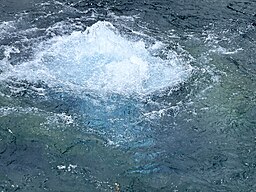“But they deliberately forget that long ago by God’s word the heavens came into being and the earth was formed out of water and by water. By these waters also the world of that time was deluged and destroyed” (2 Peter 3:5-6).
This description of the earth’s formation draws our attention to the creation account of Genesis chapter one…
“Now the earth was formless and empty, darkness was over the surface of the deep, and the Spirit of God was hovering over the waters” (Genesis 1:2 NIV).
Other translations of Genesis 1:2 tell us that the earth was “…without form and void…” (ESV) or “…a shapeless, chaotic mass…” (TLB) at this stage in its development. This lends support to the idea that God first established the components that later became the universe as we know it (Genesis 1:1). For instance, we might interpret this passage to mean that the constituent elements of creation were suspended in a formless, fluid state during this phase. Yet, Earth seems to have been separate and distinct almost from the moment of creation.
One source offers some insight into what likely occurred during that process…
“In the first stage of creation, after the second day, the earth material was surrounded by vast waters above the firmament and suspended in other waters under the firmament {Ge 1:7). The waters beneath the ‘firmament’ (the ‘expanse’ of the troposphere) later were either formed into seas or confined in a ‘great deep’ beneath the earth’s crust. This regime apparently continued until the time of the great flood when they all came together again. Until then the earth was ‘standing’ (Greek sunistemi- that is, being ‘sustained’) in and by the waters.” (1)
 This also corresponds to what we read later in Genesis 7:10-12. That portion of Scripture tells us “…all the underground waters erupted from the earth” (NLT) at the time of Noah’s flood. The sudden emergence of those underground pockets of water would have led to the catastrophic results associated with the flood.
This also corresponds to what we read later in Genesis 7:10-12. That portion of Scripture tells us “…all the underground waters erupted from the earth” (NLT) at the time of Noah’s flood. The sudden emergence of those underground pockets of water would have led to the catastrophic results associated with the flood.
So it wasn’t just the falling rain that produced Noah’s flood. Instead, it was the torrential downpour from above, coupled with the corresponding surge from the water table below.
So while life on this planet cannot survive without the presence of water, it is a curious irony to note how God employed that same element as a catalyst for the destruction of the ancient world along with the wickedness of its inhabitants. Thus, “…it was by means of these the world that then existed was deluged with water and perished” (ESV).
Image Credit: James St. John, CC BY 2.0, via Wikimedia Commons
(1) Institute for Creation Research, New Defender’s Study Bible Notes [2 Peter 3:5] https://www.icr.org/bible/2Pet/3/5/ Accessed 02 September, 2024

